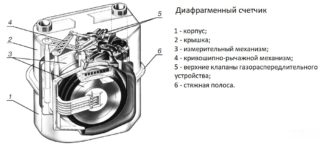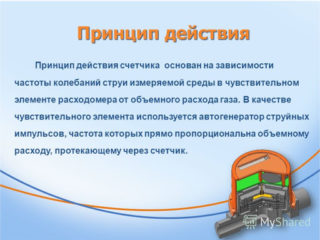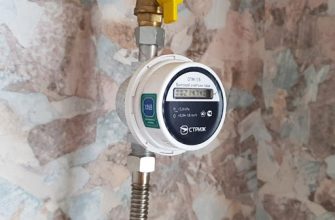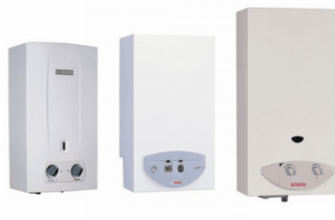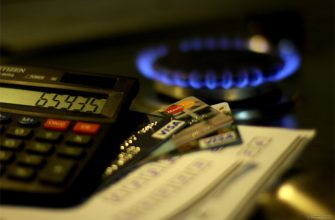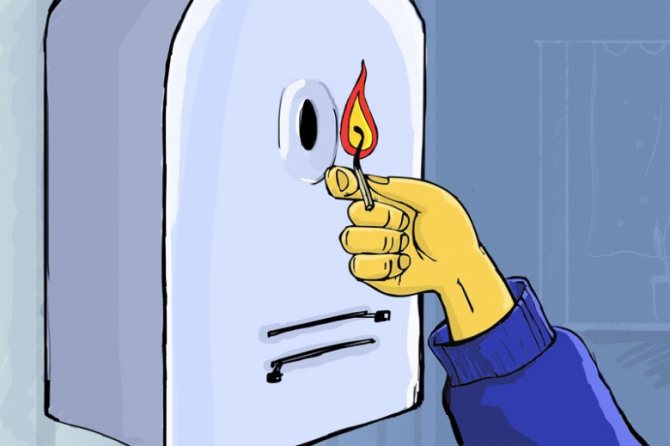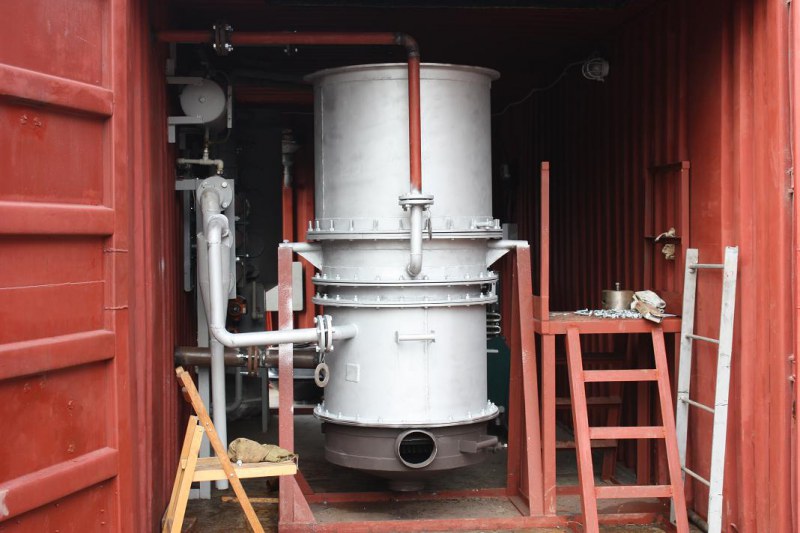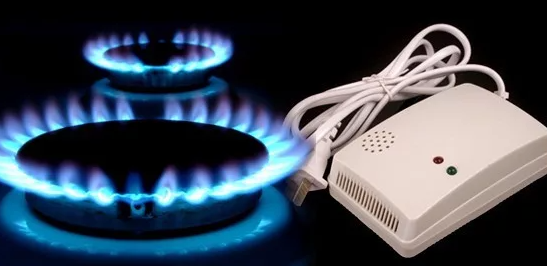To account for gas consumption in private homes and enterprises, a flow meter is installed. The device of a gas meter can be different. The difference in design does not affect the measurement accuracy. But this affects the duration of operation, reliability and repair features of the device.
The need for a gas meter
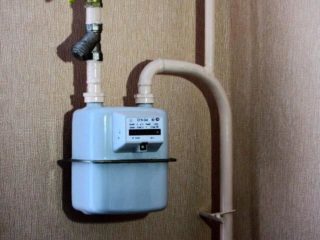
Federal Law No. 261 "On Energy Supply" obliges all owners of private houses and apartments to install a gas meter of a suitable design in their dwellings. Installation is carried out at the expense of the consumer. Some categories of citizens are an exception: in this case, the flow meters are installed free of charge.
Installation of devices is required. If the landlord refuses to voluntarily install the flow meter, the gas service employee has the right to do so forcibly. Otherwise, Gorgaz has the right to file a lawsuit against the obstruction of maintenance. With a positive decision of the court, the owner is charged with the obligation to pay for the installation of the meter and a fine.
In fact, the terms of mandatory equipment with flow meters have been extended several times. There are not enough accounting means and specialists, the queues for the installation of the flow meter are huge. This allows many private home owners to ignore the government's demand.
The first step in the installation process is to apply to your local gas office. If the owner does not submit it, no sanctions can be applied to him. And since there is a large queue of those who are already waiting for installation, Gorgaz temporarily ignores people who evade the installation.
If the apartment has only 1 gas appliance - a stove, and gas is consumed only for cooking, it is allowed not to install a flow meter.
Varieties of gas meters
The gas meter measures the gas consumption. The device is built into the gas circuit through which the energy carrier is supplied to the dwelling. In a private house or enterprise, the device is mounted on the street - in a special cabinet under a canopy. In an apartment building, the flow meter is installed directly in the room.
The device of a gas meter depends on many facts: registration measurement mechanisms, power supply, purpose, bandwidth. The main categories are considered to be 2:
- Mechanical - gas flows through the pipe at a certain speed, depending on the pressure. Its flow drives the transmission mechanism to the calculating device.
- Electronic - sensors determine the volume of the transported gas and send the appropriate impulses. The number of impulses is recorded and converted into flow meter readings. Electronic models are equipped with an LCD display.
Each species has its own advantages and disadvantages. Mechanical models are easier to maintain, independent of electricity. Electronic ones are more accurate and last longer.
By design, accounting means are divided into 5 groups.
Membrane
Advantages of the membrane arrangement:
- the term of operation is more than 20 years - this is important, since the replacement of the used meter is made at the expense of the consumer;
- large check-up interval - 10 years;
- can work with insufficiently purified methane;
- low price.
Disadvantages:
- large sizes - it is difficult to find a place for him in a cramped kitchen;
- the appliance is noisy, and the higher the flow rate, the stronger the noise produced.
The design is complex, but reliable. Several sensitive diaphragms are connected to a duct and valve system. When gas enters the meter, it fills the first chamber, after which the valve opens and passes the gas into the second. The cycle is constantly repeated while gas flows through the pipe. Since the volume of the chamber is known, it is easy to recalculate the number of openings in the volume of gas passed through the meter. The valves are controlled by transmitting force through the crank mechanism.
Rotary
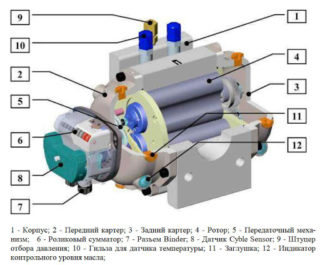
A variety of mechanical models. They are used in everyday life, in boiler rooms, in small and medium-sized enterprises. They do not depend on electricity, they are reliable, they can easily withstand short-term loads.
The principle of operation is as follows: 2 eight-shaped rotors rotate in the body, rolling around with side surfaces. The first is associated with the transmission mechanism, the second with the counting mechanism. The rotors rotate due to the difference in gas pressure that occurs when entering through the inlet and leaving through the outlet.
The measurement accuracy depends on the ease of movement of the rotors. When inspecting the meter, this parameter is carefully evaluated.
Turbine
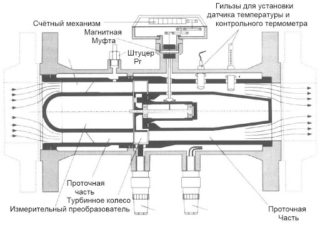
They are more complex in design and include a turbine with rotation supports, a jet rectifier and a pumping unit. The latter serves the rotation bearings. The turbine rotates at different speeds depending on the pressure. The number of revolutions is fixed by the counter mechanism.
A mechanical device can be automated. In this case, the control over the accounting is performed by the computing device.
The turbine meter is reliable, easy to maintain, and produces little noise during operation. Used in enterprises. Disadvantage: The measurement accuracy depends on the stability and continuity of the flow. In the pulsating mode, the measurement error increases noticeably.
Drum
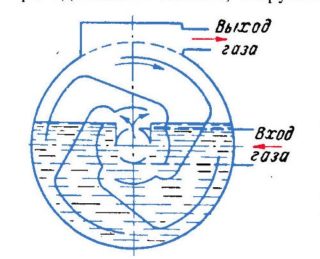
Such a counter works on the principle of displacement. In the barrier liquid - water, oil - the drum rotates under the influence of pressure. In this case, 4 measuring chambers are filled and emptied. The gas volume in this case is measured directly. Careful camera calibration ensures very high measurement accuracy.
The drum meter readings do not depend on the temperature or the degree of gas purification.
The devices are used in places where high accuracy is most important: in factory laboratories, in institutes.
Vortex

They are based on the creation of a vortex motion in the flow of gas, vapor or liquid. In the pipe through which the gas is supplied, a trapezoidal streamline body and sensors are installed that record the magnitude of the vortices that appear. The pairing of sensors provides a higher measurement accuracy and insensitivity to vibration and acoustic interference.
Vortex gas meters are designed to operate in pipes with a diameter of 50 to 500 mm at a pressure of up to 30 MPa and a temperature of -60 to +500 C.
Device and principle of operation
- The diaphragm meter is divided into 2 or more chambers. Each is connected to the valve mechanism, and a counter is connected to the shaft of the latter.
- The rotary structure is similar. Here, mechanical energy is generated by rotating rotors.
- in the turbine, the working fluid is the turbine.
Although the instruments themselves are mechanical, the calculator in modern models is a real computer system.
Counter circuit
The general scheme is as follows:
- A working fluid or a mechanism placed in a gas stream does some kind of mechanical work: the rotor rotates, the chambers are filled.
- Mechanical work is recorded in some way: the counter registers the number of revolutions, the chambers measure the volume of gas, the rotation energy is converted into electrical signals.
- The sensors transmit data to the measuring device. The latter is usually placed on a tube.
The design may include additional accessories. For example, a temperature compensator avoids errors when the temperature rises.
The principle of operation of an electronic gas meter
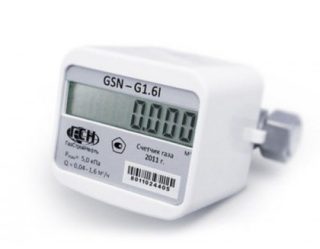
Smart gas meters are equipped with electronic measuring modules. The devices are fully automated and usually independent of electricity. The electronics are powered by a rechargeable battery.
The electronic module offers several advantages:
- Greater measurement accuracy - the conversion of mechanical energy into electrical energy is performed faster and more accurately, sensor sensors allow you to take into account changes in pressure at different gas temperatures, etc.
- The meters are equipped with LCD displays. They are more convenient and convey more information to the user.
- Modules have memory. The device allows you to register current indicators and compare all measurements over a long time.
- Accuracy of adjustment - the measuring modules are literally "adjusted" to the parameters of the supplied gas.
- Electronics needs more protection. But as a result, the entire device is more durable.
Models may include options: a gas leakage shut-off valve, a smart card reader that allows you to pay for blue fuel immediately.
Selection rules
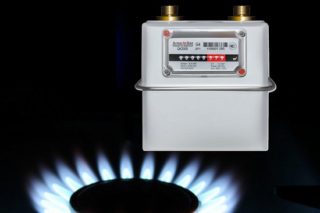
Appliance selection is based on the recommendations of the building gas company. On their part, these requirements are due to the peculiarities of the gas circuit, the degree of gas purification, and maintainability.
The user also takes into account other characteristics:
- Throughput - the maximum volume of gas that the device can pass through, indicated in the product passport. The throughput of the flow meter must exceed the total consumption of all gas appliances in the dwelling by 10%.
- Design features - they produce right-hand and left-hand counters. Depending on the direction of supply of the gas mixture - left or right, select the desired type of device. The diameter of the connecting pipe is also taken into account: it must match the section of the pipe.
- Thermocorrector - the gas changes in volume when the temperature rises or falls. A conventional flow meter is designed to measure at a normal temperature of +20 C. The thermocorrector takes into account changes in volume.
- Date of manufacture - the service life of the device begins not from the moment of installation, but from the date of manufacture. It is indicated in the data sheet.
- Place of installation of the meter.
- Calibration interval - the longer it is, the less often you will have to pay for inspection.
The temperature in the apartment is kept stable. The thermocorrector is required in private houses and in boiler rooms.
Installation features
- According to the rules, the temperature of the supplied gas should be in the range from -20 to +60 C. In fact, the smaller the spread, the better. If we are talking about a country house, threaded gas pipes should be insulated.
- Install the flow meter at a height of at least 1.6 m. A distance of 0.8 to 1 m is maintained to the heating devices that affect the operation of the meter.
- The room in which the meter is mounted must be well ventilated.
- In an apartment building, before installation, the gas supply is turned off in the entire entrance. Shut-off valves are closed on the supply gas pipelines.
After installation, the meter must be sealed before commissioning.
Advantages and disadvantages
The advantage of any calculating and measuring instrument is the ability to accurately estimate the flow rate.An approximate measurement based on average consumption rates actually forces the consumer to pay 30% more. The counter solves this problem.
Disadvantages are associated with the need to install, maintain and replace devices at the end of their service life. These procedures are not free: the consumer pays for the counter, technical inspection and repairs.

